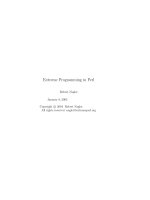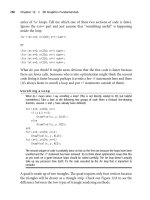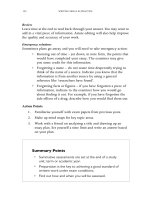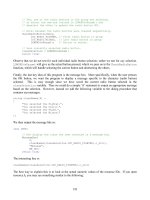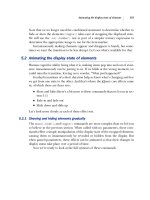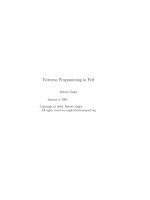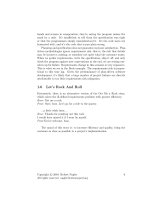Extreme Programming in Perl Robert Nagler phần 7 pot
Bạn đang xem bản rút gọn của tài liệu. Xem và tải ngay bản đầy đủ của tài liệu tại đây (1.21 MB, 24 trang )
We want asymmetric weights so that defects, such as swapping today’s price
and yesterday’s average, will be detected. A length of 4 yields an alpha of
2/5 (0.4), and makes the equation asymmetric:
today’s average = today’s price x 0.4 + yesterday’s average x 0.6
With alpha fixed at 0.4, we can pick prices that make today’s average an
integer. Specifically, multiples of 5 work nicely. I like prices to go up, so I
chose 10 for today’s price and 5 for yesterday’s average. (the initial price).
This makes today’s average equal to 7, and our test becomes:
ok(my $ema = EMA->new(4));
is($ema->compute(5), 5);
is($ema->compute(5), 5);
is($ema->compute(10), 7);
Again, I revised the base cases to keep the test s hort. Any value in the
base cases will work so we might as well save testing time through reuse.
Our test and implementation are essentially complete. All paths through
the code are tested, and EMA could be used in production if it is used properly.
That is, EMA is complete if all we care about is conformant behavior. The
implementation currently ignores what happens when new is given an invalid
value for $length.
11.9 Fail Fast
Although EMA is a small part of the application, it can have a great impact on
quality. For example, if new is passed a $length of -1, Perl throws a divide-
by-zero exception when alpha is computed. For other invalid values for
$length, such as -2, new silently accepts the errant value, and compute faith-
fully produces non-sensical values (negative averages for positive prices). We
can’t simply ignore these cases. We need to make a decision about what to
do when $length is invalid.
One approach would be to assume garbage-in garbage-out. If a caller
supplies -2 for $length, it’s the caller’s problem. Yet this isn’t what Perl’s
divide function does, and it isn’t what happens, say, when you try to de-
reference a scalar which is not a reference. The Perl interpreter calls die,
and I’ve already mentioned in the Coding Style chapter that I prefer failing
fast rather than waiting until the program can do some real damage. In our
Copyright
c
2004 Robert Nagler
All rights reserved
91
example, the customer’s web site would display an invalid moving average,
and one her customers might make an incorrect investment decision based on
this information. That would be bad. It is better for the web site to return
a server error page than to display misleading and incorrect information.
Nobody likes program crashes or server errors. Yet calling die is an
efficient way to communicate semantic limits (couplings) within the appli-
cation. The UI programmer, in our example, may not know that an EMA’s
length must be a positive integer. He’ll find out when the application dies.
He can then change the design of his code and the EMA class to make this
limit visible to the end user. Fail fast is an important feedback mechanism.
If we encounter an unexpected die, it tells us the application design needs
to be improved.
11.10 Deviance Testing
In order to test for an API that fails fast, we need to be able to catch calls
to die and then call ok to validate the call did indeed end in an exception.
The function dies ok in the module Test::Exception does this for us.
Since this is our last group of test cases in this chapter, here’s the entire
unit test with the changeds for the new deviance cases highlighted:
use strict;
use Test::More tests => 9; use Test::Exception;
BEGIN {
use_ok(’EMA’);
}
ok(my $ema = EMA->new(4));
is($ema->compute(5), 5);
is($ema->compute(5), 5);
is($ema->compute(10), 7); dies ok {EMA->new(-2)}; dies ok {EMA->new(0)};
lives ok {EMA->new(1)}; dies ok {EMA->new(2.5)};
There are now 9 cases in the unit test. The first deviance case validates
that $length can’t be negative. We already know -1 will die with a divide-
by-zero exception so -2 is a better choice. The zero case checks the boundary
condition. The first valid length is 1. Lengths must be integers, and 2.5 or
any other floating point number is not allowed. $length has no explicit
upper limit. Perl automatically converts integers to floating point numbers
Copyright
c
2004 Robert N agler
All rights reserved
92
if they are too large. The test already checks that floating point numbers
are not allowed so no explicit upper limit check is required.
The implementation that satisfies this test follows:
package EMA;
use strict;
sub new {
my($proto, $length) = @_; die("$length: length must be a positive
32-bit integer") unless $length =~ /^\d+$/ && $length >= 1 && $length
<= 0x7fff ffff;
return bless({
alpha => 2 / ($length + 1),
}, ref($proto) || $proto);
}
sub compute {
my($self, $value) = @_;
return $self->{avg} = defined($self->{avg})
? $value * $self->{alpha} + $self->{avg} * (1 - $self->{alpha})
: $value;
}
1;
The only change is the addition of a call to die with an unless clause.
This simple fail fast clause doesn’t complicate the code or slow down the
API, and yet it prevents subtle errors by converting an assumption into an
assertion.
11.11 Only Test The New API
One of the most difficult parts of testing is to know when to stop. Once
you have been test-infected, you may want to keep on adding cases to be
sure that the API is “pe rfect”. For example, a interesting test case would
be to pass a NaN (Not a Number) to compute, but that’s not a test of EMA.
The floating point implementation of Perl behaves in a particular way with
Copyright
c
2004 Robert Nagler
All rights reserved
93
respect to NaNs
6
, and Bivio::Math::EMA will conform to that behavior.
Testing that NaNs are handled properly is a job for the Perl interpreter’s
test suite.
Every API relies on a tremendous amount of existing code. There isn’t
enough time to test all the existing APIs and your new API as well. Just as
an API should separate concerns so must a test. When testing a new API,
your concern should be that API and no others.
11.12 Solid Foundation
In XP, we do the simplest thing that could possibly work so we can deliver
business value as quickly as possible. Even as we write the test and im-
plementation, we’re sure the code will change. When we encounter a new
customer requirement, we refactor the code, if need be, to facilitate the ad-
ditional function. This iterative proces s is called continuous design, which
is the subject of the next chapter. It’s like renovating your house whenever
your needs change.
7
A system or house needs a solid foundation in order to support con-
tinuous renovation. Unit tests are the foundation of an XP project. When
designing continuously, we make sure the house doesn’t fall down by running
unit tests to validate all the assumptions about an implementation. We also
grow the foundation before adding new functions. Our test suite gives us
the confidence to embrace change.
6
In some implementations, use of NaNs will cause a run-time error. In others, they
will cause all subsequent results to be a NaN.
7
Don’t let the thought of continuous house renovation scare you off. Programmers are
much quieter and less messy than construction workers.
Copyright
c
2004 Robert N agler
All rights reserved
94
Chapter 12
Continuous Design
In the beginning was simplicity.
– Richard Dawkins
1
Software evolves. All systems are adapted to the needs of their users and
the circumstances in which they operate, even after years of planning.
2
Some
people call this maintenance programming, implementing change requests,
or, simply, firefighting. In XP, it’s called continuous design, and it’s the only
way we design and build systems. Whatever you call it, change happens,
and it involves two activities: changing what the code does and improving
its internal structure.
In XP, these two activities have names: implementing stories and refac-
toring. Refactoring is the process of making code b e tter without changing
its external behavior. The art of refactoring is a fundamental skill in pro-
gramming. It’s an important part of the programmer’s craft to initiate
refactorings to accommodate changes requested by the customer. In XP, we
use tests to be sure the behavior hasn’t changed.
As any implementation grows, it needs to be refactored as changes (new
features or defect fixes) are introduced. Sometimes we refactor before imple-
menting a story, for example, to expose an existing algorithm as its own API.
Other times, we refactor after adding a new feature, because we only see
how to eliminate unnecessary duplication, after the feature is implemented.
This to and fro of code expansion (implementing stories) and contraction
(refactoring) is how the design evolves continuously. And, by the way, this is
1
The Selfish Gene, Richard Dawkins, Oxford University Press, 1989, p. 12.
2
The most striking and recent example was the failure, debugging, and repair of the
Mars Exploration Rover Spirit.
95
how Perl was designed: on demand and continuously. It’s one of the reasons
Perl continues to grow and thrive w hile other languages whither and die.
This chapter evolves the design we started in Test-Driven Design. We
introduce refactoring by simplifying the EMA equation. We add a new class
(simple moving average) to satisfy a new story, and then we refactor the two
classes to share a common base class. Finally, we fix a defect by exposing
an API in b o th classes, and then we refactor the APIs into a single API in
the base class.
12.1 Refactoring
The first step in continous design is to b e sure you have a test. You need
a test to add a story, and you use existing tests to be sure you don’t break
anything with a refactoring. This chapter picks up where Test-Driven Design
left off. We have a working exponentional moving average (EMA) module
with a working unit test.
The first improvement is a simple refactoring. The equation in compute
is more complex than it needs to be:
sub compute {
my($self, $value) = @_;
return $self->{avg} = defined($self->{avg})
? $value * $self->{alpha} + $self->{avg} * (1 - $self->{alpha})
: $value;
}
The refactored equation yields the same results and is simpler:
sub compute {
my($self, $value) = @_;
return $self->{avg} += defined($self->{avg})
? $self->{alpha} * ($value - $self->{avg})
: $value;
}
After the refactoring, we run our test, and it passes. That’s all there is
to refactoring. Change the code, run the test for the module(s) we are mod-
Copyright
c
2004 Robert N agler
All rights reserved
96
ifying, run the entire unit test suite, and then check in once all tests pass.
Well, it’s not always that easy, sometimes we make mistakes. That’s what
the tests are for, and tests are what simplifies refactoring.
12.2 Simple Moving Average
Our hypothetical customer would like to expand her website to compete
with Yahoo! Finance. The following graph shows that Yahoo! offers two
moving averages:
Yahoo! 20 day moving averages on 3 month graph from May 18,
2004
3
In order to provide the equivalent functionality, we need to implement
a simple moving average (SMA or MA in Yahoo!’s graph). An SMA is the
arithmetic mean of the last N periods of the price series. For a daily graph,
we add in the new day’s price and we remove the oldest price from the sum
before we take the average.
12.3 SMA Unit Test
The following test demonstrates the algorithm. The test was created by
starting with a copy of the EMA test from the Test-Driven Design chapter.
We replaced EMA with SMA, and changed the values to match the SMA
3
http://finance.yahoo.com/q/ta?s=RHAT&t=3m&p=e20,m20
Copyright
c
2004 Robert Nagler
All rights reserved
97
algorithm:
use strict;
use Test::More tests => 11;
use Test::Exception;
BEGIN {
use_ok(’SMA’);
}
ok(my $sma = SMA->new(4));
is($sma->compute(5), 5);
is($sma->compute(5), 5);
is($sma->compute(11), 7);
is($sma->compute(11), 8);
is($sma->compute(13), 10);
dies_ok {SMA->new(-2)};
dies_ok {SMA->new(0)};
lives_ok {SMA->new(1)};
dies_ok {SMA->new(2.5)};
Like the EMA, the SMA stays constant (5) when the input values remain
constant (5). The deviance cases are identical, which gives us another clue
that the two algorithms have a lot in common. The difference is that average
value changes differently, and we need to test the boundary condition when
values “fall off the end” of the average.
12.4 SMA Implementation
The EMA and the SMA unit test are almost identical. It follows that the
implementations should be nearly identical. Some people might want to
create a base class so that SMA and EMA could share the common code.
However, at this stage, we don’t know what that code might be. That’s
why we do the simplest thing that could possibly work, and copy the EMA
class to the SMA clas s. And, let’s run the test to see what happens after we
change the package name from EMA to SMA:
1 11
ok 1 - use SMA;
ok 2
Copyright
c
2004 Robert N agler
All rights reserved
98
ok 3
ok 4
not ok 5
# Failed test (SMA.t at line 10)
# got: ’7.4’
# expected: ’7’
not ok 6
# Failed test (SMA.t at line 11)
# got: ’8.84’
# expected: ’8’
not ok 7
# Failed test (SMA.t at line 12)
# got: ’10.504’
# expected: ’10’
ok 8
ok 9
ok 10
ok 11
# Looks like you failed 3 tests of 11.
The test fails, because an EMA algorithm in an SMA’s clothing is still
an EMA. That’s good. Otherwise, this section would be way too short.
Without further ado, here’s the c orrect algorithm:
package SMA;
use strict;
sub new {
my($proto, $length) = @_;
die("$length: length must be a positive 32-bit integer")
unless $length =~ /^\d+$/ && $length >= 1 && $length <= 0x7fff_ffff;
return bless({
length => $length,
values => [],
}, ref($proto) || $proto);
}
sub compute {
my($self, $value) = @_;
Copyright
c
2004 Robert Nagler
All rights reserved
99
$self->{sum} -= shift(@{$self->{values}})
if $self->{length} eq @{$self->{values}};
return ($self->{sum} += $value) / push(@{$self->{values}}, $value);
}
1;
The sum calculation is different, but the basic structure is the same. The
new method checks to makes sure that length is reasonable. We need to
maintain a queue of all values in the sum, because an SMA is a FIFO al-
gorithm. When a value is more than length periods old, it has absolutely
no affect on the average. As an aside, the SMA algorithm pays a price for
that exactness, because it must retain length values where EMA requires
only one. That’s the main reason why EMAs are more popular than SMAs
in financial engineering applications.
For our application, what we care about is that this implementation
of SMA satisfies the unit test. We also note that EMA and SMA have
a lot in common. However, after satisfying the SMA test, we run all the
unit tests to be sure we didn’t inadvertently modify another file, and then
we checkin to be sure we have a working baseline. Frequent checkins is
important when designing continuously. Programmers have to be free to
make changes knowing that the source repository always holds a recent,
correct implementation.
12.5 Move Common Features to a Base Class
The SMA implementation is functionally correct, but it isn’t a good design.
The quick copy-and-paste job was necessary to start the implementation,
and now we need to go back and improve the design through a little refac-
toring. The classes SMA and EMA can and should share code. We want to
represent each conce pt once and only once so we only have to fix defects in
the implementation of the concepts once and only once.
The repetitive code is contained almost entirely in the new methods of
SMA and EMA. The obvious solution is to create a base class from which SMA
and EMA are derived. This is a very common refactoring, and it’s one you’ll
use over and over again.
Since this is a refactoring, we don’t write a new test. The refactoring
must not change the observable behavior. The existing unit tests validate
Copyright
c
2004 Robert Nagler
All rights reserved
100
that the behavior hasn’t changed. That’s what differentiates a refactoring
from simply changing the code. Refactoring is the discipline of making
changes to improve the design of existing code without changing the external
behavior of that code.
The simple change we are m aking now is moving the common parts of
new into a base class called MABase:
package MABase;
use strict;
sub new {
my($proto, $length, $fields) = @_;
die("$length: length must be a positive 32-bit integer")
unless $length =~ /^\d+$/ && $length >= 1 && $length <= 0x7fff_ffff;
return bless($fields, ref($proto) || $proto);
}
1;
The corresponding change to SMA is:
use base ’MABase’;
sub new {
my($proto, $length) = @_;
return $proto->SUPER::new($length, {
length => $length,
values => [],
});
}
For brevity, I left out the the EMA changes, which are similar to these. Note
that MABase doesn’t share fields between its two subclasses. The only com-
mon code is checking the length and blessing the instance is shared.
Copyright
c
2004 Robert Nagler
All rights reserved
101
12.6 Refactor the Unit Tests
After we move the common code into the base clase, we run all the existing
tests to be sure we didn’t break anything. However, we aren’t done. We
have a new class, which deserves its own unit test. EMA.t and SMA.t have
four cases in common. That’s unnecessary duplication, and here’s MABase.t
with the cases factored out:
use strict;
use Test::More tests => 5;
use Test::Exception;
BEGIN {
use_ok(’MABase’);
}
dies_ok {MABase->new(-2, {})};
dies_ok {MABase->new(0, {})};
lives_ok {MABase->new(1, {})};
dies_ok {MABase->new(2.5, {})};
After running the new test, we refactor EMA.t (and similarly SMA.t) as
follows:
use strict;
use Test::More tests => 5;
BEGIN {
use_ok(’EMA’);
}
ok(my $ema = EMA->new(4));
is($ema->compute(5), 5);
is($ema->compute(5), 5);
is($ema->compute(10), 7);
By removing the redundancy, we make the classes and their tests cohe-
sive. MABase and its test is concerned with validating $length. EMA and
SMA are responsible for computing moving averages. This conceptual clarity,
also known as cohesion, is what we strive for.
Copyright
c
2004 Robert N agler
All rights reserved
102
12.7 Fixing a Defect
The design is better, but it’s wrong. The customer noticed the difference
between the Yahoo! graph and the one produced by the algorithms above:
Incorrect moving average graph
The lines on this graph start from the same point. On the Yahoo! graph
in the SMA Unit Test, you see that the moving averages don’t start at the
same value as the price. The problem is that a 20 day moving average
with one data point is not valid, because the single data point is weighted
incorrectly. The results are skewed towards the initial prices.
The solution to the problem is to “build up” the moving average data
before the initial display p oint. The build up period varies with the type of
moving average. For an SMA, the build up length is the same as the length
of the average minus one, that is, the average is c orrectly weighted on the
“length” price. For an EMA, the build up length is usually twice the length,
because the influence of a price doesn’t simply disappear from the average
after length days. Rather the price’s influence decays over time .
The general concept is essentially the same for both averages. The al-
gorithms themselves aren’t different. The build up period simply means
that we don’t want to display the prices. separate out compute and value.
Compute returns undef. value blows up. is ok or will compute ok? The
two calls are inefficent, but the design is simpler. Show the gnuplot code to
generate the graph. gnuplot reads from stdin? The only difference is that
the two algorithms have different build up lengths. The easiest solution is
therefore to add a field in the sub-classes which the base classes exposes via
a method called build up length. We need to expand our tests first:
use strict;
use Test::More tests => 6;
Copyright
c
2004 Robert Nagler
All rights reserved
103
BEGIN {
use_ok(’EMA’);
}
ok(my $ema = EMA->new(4)); is($ema->build up length, 8);
is($ema->compute(5), 5);
is($ema->compute(5), 5);
is($ema->compute(10), 7);
The correct answer for EMA is always two times length. It’s simple enough
that we only need one case to tes t it. The change to SMA.t is similar.
To satisfy these tests, we add build up length to MABase:
sub build_up_length {
return shift->{build_up_length};
}
The computation of the value of build up length requires a change to new
in EMA:
sub new {
my($proto, $length) = @_;
return $proto->SUPER::new($length, {
alpha => 2 / ($length + 1), build up length => $length * 2,
});
}
The change to SMA is similar, and left out for brevity. After we fix the
plotting code to reference build up length, we end up with the following
graph:
Moving average graph with correction for build up period
Copyright
c
2004 Robert N agler
All rights reserved
104
12.8 Global Refactoring
After releasing the build up fix, our customer is happy again. We also
have some breathing room to fix up the design again. When we added
build up length, we expos ed a configuration value via the moving average
object. The plotting module also needs the value of length to print the
labels (“20-day EMA” and “20-day SMA”) on the graph. This configuration
value is passed to the moving average object, but isn’t exposed via the
MABase API. That’s bad, because length and build up length are related
configuration values. The plotting module needs both values.
To test this feature, we add a test to SMA.t (and similarly, to EMA.t):
use strict;
use Test::More tests => 8;
BEGIN {
use_ok(’SMA’);
}
ok(my $sma = SMA->new(4));
is($sma->build_up_length, 3); is($sma->length, 4);
is($sma->compute(5), 5);
is($sma->compute(5), 5);
is($sma->compute(11), 7);
is($sma->compute(11), 8);
We run the test to see that indeed length does not exist in MABase or
its subclasses. Then we add length to MABase:
sub length {
Copyright
c
2004 Robert Nagler
All rights reserved
105
return shift->{length};
}
SMA already has a field called length so we only need to change EMA to
store the length:
sub new {
my($proto, $length) = @_;
return $proto->SUPER::new($length, {
alpha => 2 / ($length + 1),
build_up_length => $length * 2, length => $length,
});
}
This modification is a refactoring even though external behavior (the API)
is different. When an API and all its clients (importers) change, it’s called
a global refactoring. In this case, the global refactoring is backwards com-
patible, because we are adding new behavior. The clients were using a copy
of length implicitly. Adding an explicit length me thod to the API change
won’t break that behavior. However, this type of global refactoring can
cause problems down the road, because old implicit uses of length still will
work until the behavior of the length method changes. At which point,
we’ve got to know that the implicit coupling is no longer valid.
That’s why te sts are so important with continuous design. Global refac-
torings are easy when each module has its own unit test and the application
has an acceptance test suite. The tests will more than likely catch the case
where implicit couplings go wrong either at the time of the refactoring or
some time later. Without tests, global refactorings are scary, and most pro-
grammers don’t attempt them. When an implicit coupling like this becomes
cast in stone, the code base is a bit more fragile, and continous design is a bit
harder. Without some typ e of remediation, the policy is “don’t change any-
thing”, and we head down the slippery slope that some people call Software
Entropy.
4
4
Software Entropy is often defined as software that “loses its original design structure”
( entropy.html). Continuous design turns
the concept of software entropy right side up (and throws it right out the window) by
changing the focus from the code to what the software is suppos ed to do. Software entropy
is meaningless when there are tests that specify the expected behavior for all parts of an
Copyright
c
2004 Robert Nagler
All rights reserved
106
application. The tests eliminate the fear of change inherent in non-test-driven software
metho dologies.
Copyright
c
2004 Robert Nagler
All rights reserved
107
12.9 Continuous Rennovation in the Real
World
Programmers often use building buildings as a metaphor for cre-
ating software. It’s often the wrong model, because it’s not easy
to copy-and-paste. The physical world doesn’t allow easy replica-
tion beyond the gene level. However, continuous design is more
commonplace than many people might think. My company had
our office rennovated before we moved in. Here is a view of the
kitchen (and David Farber) before the upgrade:
Before rennovation
After the rennovation, the kitchen looked like this:
After rennovation
If a couple of general contractors can restructure an office in a
few weeks, imagine what you can do with your software in the
same time. The architectural plans did change continuously dur-
ing the implementation. The general contractors considered this
completely normal. After all, it’s impossible for the customer to
get a good idea what the office will look like until the walls start
going up.
Copyright
c
2004 Robert Nagler
All rights reserved
108
12.10 Simplify Accessors
Software entropy creeps in when the software fails to adapt to a change. For
example, we now have two accessors that are almost identical:
sub length {
return shift->{length};
}
sub build_up_length {
return shift->{build_up_length};
}
The code is repeated. That’s not a big problem in the specific, because
we’ve only done it twice. This subtle creep gets to be a bigger problem
when someone else copies what we’ve done here. Simple copy-and-paste is
probably the single biggest cause of software rot in any system. New pro-
grammers on the project think that’s how “we do things here”, and we’ve
got a s tandard practice for copying a single error all over the code. It’s not
that this particular code is wrong; it’s that the practice is wrong. This is
why it’s important to stamp out the practice when you can, and in this case
it’s very easy to do.
We can replace both accessors with a single new API called get. This
global refactoring is very easy, because we are removing an existing API.
That’s another reason to make couplings explicit: when the API changes,
all uses fail with method not found. The two unit test cases for EMA now
become:
is($ema->get(’build_up_length’), 8);
is($ema->get(’length’), 4);
And, we replace length and build up length with a single metho d:
sub get {
return shift->{shift(@_)};
}
Copyright
c
2004 Robert Nagler
All rights reserved
109
We also refactor uses of build up length and length in the plotting mod-
ule. This is the nature of continuous rennovation: constant change every-
where. And, that’s the part that puts people off. They might ask why the
last two changes (adding length and refactoring get) were necessary.
12.11 Change Happens
Whether you like it or not, change happens. You can’t stop it. If you
ignore it, your software becomes brittle, and you have more (boring and
high stress) work to do playing catch up with the change. The proactive
practices of testing and refactoring seem unnecessary until you do hit that
defect that’s been copied all over the code, and you are forced to fix it. Not
only is it difficult to find all copies of an error, but you also have to find all
places in the code which unexpectedly depended on the behavior caused by
the defect. Errors multiply so that’s changing a single error into N-squared
errors It gets even worse when the practice of copy-and-pasting is copied.
That’s N-cubed, and that will make a mess of even the best starting code
base. Refactoring when you see replication is the only way to eliminate this
geometric effect.
Without tests, refactoring is no longer engineering, it’s hacking. Even
the best hackers hit a wall if they can’t validate a change hasn’t broken
something. They’ll create ad hoc tests if necessary. XP formalizes this
process. However, unit testing is still an art. The only way to get good at
it is by seeing more examples. The next chapter takes a deeper look at the
unit testing in a more realistic environment.
Copyright
c
2004 Robert N agler
All rights reserved
110
Chapter 13
Unit Testing
A succes sful test case is one that detects an as-yet undiscovered
error.
– Glenford Myers
1
The second and third examples test a post office protocol (POP3) client
available from CPAN. These two unit tests for Mail::POP3Client indicate
some design issues, which are addressed in the Refactoring chapter. The
third example also demonstrates how to use Test::MockObject, a CPAN
module that makes it easy to test those tricky paths through the code, such
as, error cases.
13.1 Testing Isn’t Hard
One of the common complaints I’ve heard about testing is that it is too hard
for complex APIs, and the return on investment is therefore too low. The
problem of course is the more c omplex the API, the more it needs to be
tested in isolation. The rest of the chapter demonstrates a few tricks that
simplify testing complex APIs. What I’ve found, however, the more testing
I do, the easier it is to write tests especially for c omplex APIs.
Testing is also infectious. As your suite grows, there are more examples
to learn from, and the harder it becomes to not test. Your test infrastructure
also evolves to better match the language of your APIs. Once and only once
applies to test software, too. This is how Bivio::Test came about. We
were tired of repeating ourselves. Bivio::Test lets us write subject matter
oriented programs, eve n for complex APIs.
1
Art of Software Testing, Glenford Myers, John Wiley & Sons, 1979, p. 16.
111
13.2 Mail::POP3Client
The POP3 protocol
2
is a common way for m ail user agents to retrieve mes-
sages from mail servers. As is often the case, there’s a CPAN module avail-
able that implements this protocol.
Mail::POP3Client
3
has been around for a few years. The unit test
shown below was written in the spirit of test first programming. Some of
the test cases fail, and in Refactoring, we refactor Mail::POP3Client to
make it easier to fix some of the defects found here.
This unit test shows how to test an interface that uses sockets to connect
to a server and has APIs that write files. This test touches on a number of
test and API design issues.
To minimize page flipping the test is broken into pieces, one part per
section. The first two sections discuss initialization and data selection. In
Validate Basic Assumptions First and the next section, we test the server
capabilities and authentication mechanisms match our assumptions. We
test basic message retrieval starting in Distinguish Error Cases Uniquely
followed by retrieving to files. The List, ListArray, and Uidl methods are
tested in Relate Results When You Need To. Destructive tests (deletion)
occur next after we have finished testing retrieval and listing. We validate
the accessors (Host, Alive, etc.) in Consistent APIs Ease Testing. The final
test cases cover failure injection.
13.3 Make Assumptions
use strict;
use Test::More tests => 85;
use IO::File;
use IO::Scalar;
BEGIN {
use_ok(’Mail::POP3Client’);
}
2
The Post Office Protocol - Version 3 RFC can be found at
The Mail::POP3Client also implements
the POP3 Extension Mechanism RFC, />and IMAP/POP AUTHorize Extension for Simple Challenge/Response RFC
/>3
The version being tested here is 2.12, which can be found at
/>Copyright
c
2004 Robert N agler
All rights reserved
112
my($cfg) = {
HOST => ’localhost’,
USER => ’pop3test’,
PASSWORD => ’password’,
};
To access a POP3 server, you need an account, password, and the name
of the host running the server. We made a number of assumptions to sim-
plify the test without compromising the quality of the test cases. The POP3
server on the local machine must have an account pop3test, and it must
support APOP, CRAM-MD5, CAPA, and UIDL.
The test that comes with Mail::POP3Client provides a way of configur-
ing the POP3 configuration via environment variables. This makes it easy
to run the test in a variety of environments. The purpose of that tes t is
to test the basic functions on any machine. For a CPAN module, you need
this to allow anybody to run the test. A CPAN test can’t make a lot of
assumptions about the execution environment.
In test-first programming, the most important step is writing the test.
Make all the as sumptions you need to get the test written and working. Do
the simplest thing that could possibly work, and as sume you aren’t going to
need to write a portable test. If you decide to release the code and test to
CPAN, relax the test constraints after your API works. Your first goal is to
create the API which solves your customer’s problem.
13.4 Test Data Dependent Algorithms
my($subject) = "Subject: Test Subject";
my($body) = <<’EOF’;
Test Body
A line with a single dot follows
.
And a dot and a space
.
EOF
open(MSG, "| /usr/lib/sendmail -i -U $cfg->{USER}\@$cfg->{HOST}");
print(MSG $subject . "\n\n" . $body);
close(MSG)
Copyright
c
2004 Robert Nagler
All rights reserved
113
or die("sendmail failed: $!");
sleep(1);
my($body_lines) = [split(/\n/, $body)];
$body = join("\r\n", @$body_lines, ’’);
The POP3 protocol uses a dot (.) to te rminate multi-line responses. To
make sure Mail::POP3Client handles dots correctly, we put leading dots in
the message body. The mes sage should be retrieved in its entirety, including
the lines with dots. It’s important to test data dependencies like this.
The test only sends one message. This is sufficient to validate the client
implementation. Testing the server, however, would be much more complex,
and would require multiple clients, messages, and mes sage sizes.
The sleep(1) is used to give sendmail time to deliver the message
before the test starts.
13.5 Validate Basic Assumptions First
my($pop3) = Mail::POP3Client->new(HOST => $cfg->{HOST});
$pop3->Connect;
is($pop3->State, ’AUTHORIZATION’);
like($pop3->Capa, qr/UIDL.*CRAM.*|CRAM.*UIDL/is);
ok($pop3->Close);
The first case group validates some assumptions used in the rest of the
cases. It’s important to put these first to aid debugging. If the entire test
fails catastrophically (due to a misconfigured server, for example), it’s much
easier to diagnose the errors when the basic assumptions fail first.
Bivio::Test allows you to ignore the return result of conformance cases
by specifying undef. The return value of Connect is not well-defined, so it’s
unimportant to test it, and the test documents the way the API works.
This case raises a design issue. Perl subroutines always return a value.
Connect does not have an explicit return statement, which means it returns
an arbitrary value. Perl has no implicit void context like C and Java do.
It’s always safe to put in an explicit return; in subroutines when you don’t
intend to return anything. This helps ensure predictable behavior in any
Copyright
c
2004 Robert Nagler
All rights reserved
114
